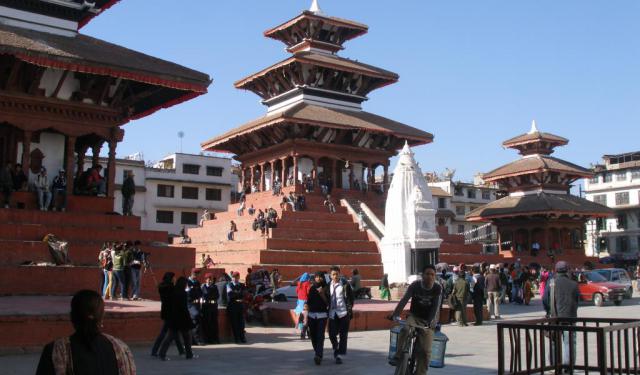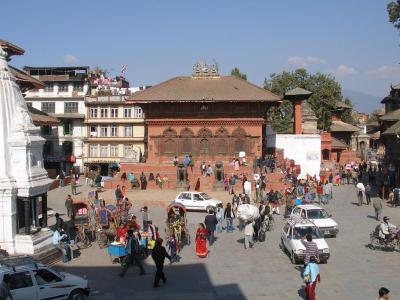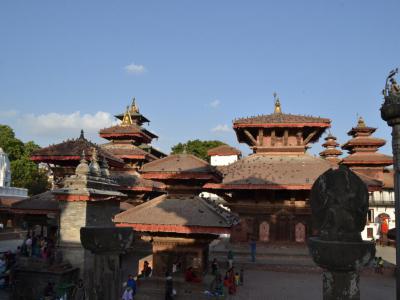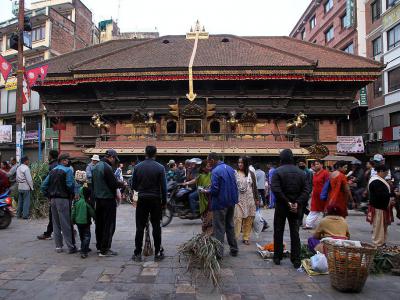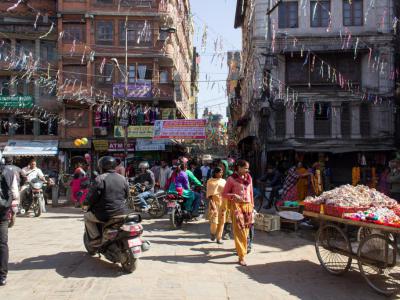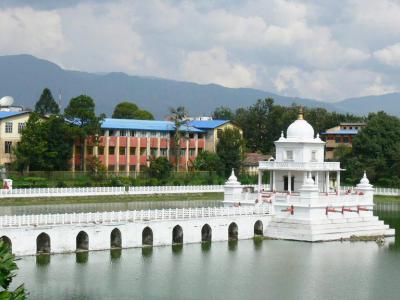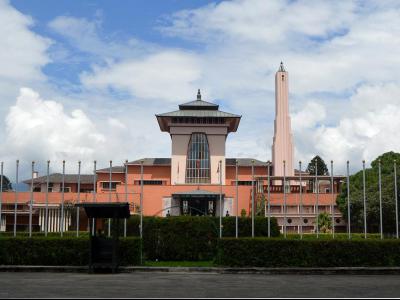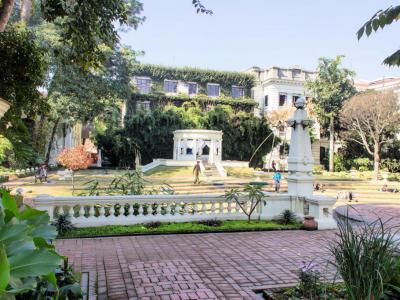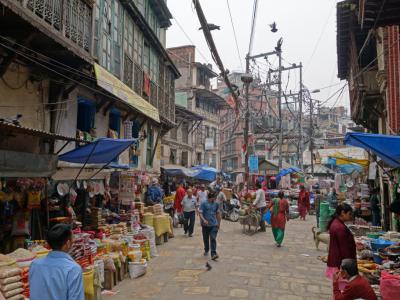Kathmandu Introduction Walking Tour (Self Guided), Kathmandu
Kathmandu is the capital city of Nepal. With nearly 3 million residents in the metropolitan region, Kathmandu is also the largest city in the country. Kathmandu is notable for being one of the oldest continuously inhabited cities in the world.
The name "Kathmandu" comes from the name of the Kasthamanadap pavilion in Durbar Square. That name comes from the Sanskrit words for "wood" and "pavilion."
The city was founded in the 2nd century. However, there is archaeological evidence that ancient civilizations lived in the area as early as 185 CE. It was a sought-after region due to its location in the valley of the Himalayas and the eight rivers that bisect the land.
The most important river for most inhabitants of Kathmandu is the Bagmati. This river is sacred to the Buddhists and Hindus who comprise the largest part of the city's population. An important ritual involves holding open-air cremations at the Cremation Ghats along the river.
Kathmandu is now a popular tourist spot for its location near the Himalayas as well as for its history and culture. The city has a number of UNESCO World Heritage Sites, including Durbar Square.
Visitors to the city will find a large number of Buddhist and Hindu temples. These temples, like the Akash Bhairab Temple, vary in size and decor. Most are open to worshipers and visitors throughout the day. Many offer evening concerts according to the phase of the moon.
Another popular activity in Kathmandu is shopping. Tourists will find handmade crafts, art, carpets and clothing accessories at the Asan Bazar and Thamel Bazar among many other shopping spots in the city. Some of these bazaars have been around for hundreds of years.
Take this self-guided walking tour to see the most historical and beautiful places in the city of Kathmandu.
The name "Kathmandu" comes from the name of the Kasthamanadap pavilion in Durbar Square. That name comes from the Sanskrit words for "wood" and "pavilion."
The city was founded in the 2nd century. However, there is archaeological evidence that ancient civilizations lived in the area as early as 185 CE. It was a sought-after region due to its location in the valley of the Himalayas and the eight rivers that bisect the land.
The most important river for most inhabitants of Kathmandu is the Bagmati. This river is sacred to the Buddhists and Hindus who comprise the largest part of the city's population. An important ritual involves holding open-air cremations at the Cremation Ghats along the river.
Kathmandu is now a popular tourist spot for its location near the Himalayas as well as for its history and culture. The city has a number of UNESCO World Heritage Sites, including Durbar Square.
Visitors to the city will find a large number of Buddhist and Hindu temples. These temples, like the Akash Bhairab Temple, vary in size and decor. Most are open to worshipers and visitors throughout the day. Many offer evening concerts according to the phase of the moon.
Another popular activity in Kathmandu is shopping. Tourists will find handmade crafts, art, carpets and clothing accessories at the Asan Bazar and Thamel Bazar among many other shopping spots in the city. Some of these bazaars have been around for hundreds of years.
Take this self-guided walking tour to see the most historical and beautiful places in the city of Kathmandu.
How it works: Download the app "GPSmyCity: Walks in 1K+ Cities" from Apple App Store or Google Play Store to your mobile phone or tablet. The app turns your mobile device into a personal tour guide and its built-in GPS navigation functions guide you from one tour stop to next. The app works offline, so no data plan is needed when traveling abroad.
Kathmandu Introduction Walking Tour Map
Guide Name: Kathmandu Introduction Walking Tour
Guide Location: Nepal » Kathmandu (See other walking tours in Kathmandu)
Guide Type: Self-guided Walking Tour (Sightseeing)
# of Attractions: 8
Tour Duration: 2 Hour(s)
Travel Distance: 2.9 Km or 1.8 Miles
Author: DanaOffice
Sight(s) Featured in This Guide:
Guide Location: Nepal » Kathmandu (See other walking tours in Kathmandu)
Guide Type: Self-guided Walking Tour (Sightseeing)
# of Attractions: 8
Tour Duration: 2 Hour(s)
Travel Distance: 2.9 Km or 1.8 Miles
Author: DanaOffice
Sight(s) Featured in This Guide:
- Durbar Square
- Hanuman Dhoka Palace
- Indra Chowk and Akash Bhairab Temple
- Asan Bazar
- Ranipokhari (Queen's Pond)
- Narayanhiti Royal Palace
- Garden of Dreams
- Thamel Bazar
1) Durbar Square (must see)
Durbar Square is a royal palace complex in Kathmandu. The square's full name is Hanuman Dhoka Durbar Square, named after the statue of Hanuman, a Hindu god, situated at the entrance.
The first royal palaces were constructed during the third century. Due to repeat reconstruction, nothing is left of those first buildings. Several structures around Durbar Square collapsed in 2015 when a 7.9 magnitude earthquake struck the region. The oldest building destroyed was the 7th-century Kasthamandap, a three-storied temple enshrining the deity of Gorakhnath.
It is thought that the existing palaces were built in the 10th century by Gunakamadeva, the ruler who founded the city of Kathmandu. They were not declared royal palaces until sometime during the reign of King Ratna Malla in the late 15th or early 16th century. The Durbar Square was the center of power until 1896 but continues to be used for coronations.
Structures around the complex include the 16th-century temples of Jagannath, Kotilingeshwara, Mahadev, Mahendreshwara, and Taleju. Other temples are the 18th-century Bhagavati Temple and the 17th-century Degutale Temple.
The Gaddi Durbar Neoclassical Palace was built in Durbar Square in 1908. It was designed in European architectural style with Greek columns and white plaster. The palace was used for coronations and to welcome heads of state from other countries. The Kumari Chock, a red-colored royal palace at the southern end of Durbar Square, is an even more popular attraction. It consists of the Raj Kumari or the Living Goddess, a preadolescence girl in a gilded cage, thought to be the human incarnation of the goddess Durga.
The Hanuman Dhoka Palace is open to visitors. Tourists can see the staterooms and the museums. The two museums inside the Hanuman Dhoka Palace are the King Tribhuvan Memorial Museum and the Mahendra Museum.
Durbar Square is a UNESCO World Heritage Site.
The first royal palaces were constructed during the third century. Due to repeat reconstruction, nothing is left of those first buildings. Several structures around Durbar Square collapsed in 2015 when a 7.9 magnitude earthquake struck the region. The oldest building destroyed was the 7th-century Kasthamandap, a three-storied temple enshrining the deity of Gorakhnath.
It is thought that the existing palaces were built in the 10th century by Gunakamadeva, the ruler who founded the city of Kathmandu. They were not declared royal palaces until sometime during the reign of King Ratna Malla in the late 15th or early 16th century. The Durbar Square was the center of power until 1896 but continues to be used for coronations.
Structures around the complex include the 16th-century temples of Jagannath, Kotilingeshwara, Mahadev, Mahendreshwara, and Taleju. Other temples are the 18th-century Bhagavati Temple and the 17th-century Degutale Temple.
The Gaddi Durbar Neoclassical Palace was built in Durbar Square in 1908. It was designed in European architectural style with Greek columns and white plaster. The palace was used for coronations and to welcome heads of state from other countries. The Kumari Chock, a red-colored royal palace at the southern end of Durbar Square, is an even more popular attraction. It consists of the Raj Kumari or the Living Goddess, a preadolescence girl in a gilded cage, thought to be the human incarnation of the goddess Durga.
The Hanuman Dhoka Palace is open to visitors. Tourists can see the staterooms and the museums. The two museums inside the Hanuman Dhoka Palace are the King Tribhuvan Memorial Museum and the Mahendra Museum.
Durbar Square is a UNESCO World Heritage Site.
2) Hanuman Dhoka Palace (must see)
Hanuman Dhoka Palace is a series of structures in Durbar Square. The five acres of the palace grounds include the Royal Palace, Taleju Temple, Hanuman Gate, the Panch Mukhi Hanuman Temple, and the Basantapur Tower.
The palace is named after the statue of the Hindu deity Hanuman, which guards the front door. Hanuman refers to the deity itself, while the word "Dhoke" is Nepali for "door."
The oldest part of the palace is the eastern wing and its courtyards. This portion was built in the mid-1500s and then expanded 100 years later by King Pratap Malla. The towers were added in 1768.
A stone drinking fountain outside of the palace is inscribed in 15 languages. It states that anyone who understands all 15 languages will drink milk, rather than water, from the fountain. There is also a stone sculpture, added in 1673, representing Lord Narasimha, the fourth avatar of the Hindu god Vishnu.
Three museums are located within the palace grounds. The Tribhuvan Museum offers items belonging to King Birendra, the tenth Shah Ruler and the King of Nepal from 1972 until 2001, including stone carvings, wooden carvings, weapons, furniture, coins, and jewels. The King Mahendra Memorial Museum displays his thrones. Mahendra was the King of Nepal from 1955 until he died in 1972. The primary museum, the Hanuman Dhoka Palace Museum, exhibits information and items from the Shah Dynasty and the history of Nepal.
The palace and its grounds were severely damaged by an earthquake in 2015.
The palace is named after the statue of the Hindu deity Hanuman, which guards the front door. Hanuman refers to the deity itself, while the word "Dhoke" is Nepali for "door."
The oldest part of the palace is the eastern wing and its courtyards. This portion was built in the mid-1500s and then expanded 100 years later by King Pratap Malla. The towers were added in 1768.
A stone drinking fountain outside of the palace is inscribed in 15 languages. It states that anyone who understands all 15 languages will drink milk, rather than water, from the fountain. There is also a stone sculpture, added in 1673, representing Lord Narasimha, the fourth avatar of the Hindu god Vishnu.
Three museums are located within the palace grounds. The Tribhuvan Museum offers items belonging to King Birendra, the tenth Shah Ruler and the King of Nepal from 1972 until 2001, including stone carvings, wooden carvings, weapons, furniture, coins, and jewels. The King Mahendra Memorial Museum displays his thrones. Mahendra was the King of Nepal from 1955 until he died in 1972. The primary museum, the Hanuman Dhoka Palace Museum, exhibits information and items from the Shah Dynasty and the history of Nepal.
The palace and its grounds were severely damaged by an earthquake in 2015.
3) Indra Chowk and Akash Bhairab Temple
Indra Chowk is a lively market square in Kathmandu. It houses colorful shops and stalls that sell a variety of wares. Visitors will see spices, textiles, beads, jewelry, ornaments, and produce. Street food stands serve traditional Nepali foods. The square is named after Indra, lord of heaven in Hindu mythology.
There are two primary temples in Indra Chowk square. These are the Seto Machindranath Temple and the Akash Bhairab Temple. The Akash Bhairab Temple is guarded by gilded statues that sit atop the entrance on a balcony.
Akash Bhairab Temple is thought to have been the palace of King Yalambar, the first king of Nepal. The head of Akash Bhairab is said to hold the spirit of the king. He is known as the God of the Sky.
The large head of Akash Bhairab is removed during the Yenya Festival each September and blessed by the living goddess Kumari. During the ceremony, a large number of worshippers come to visit the temple. They bring gifts of flowers, money, and food.
There are two primary temples in Indra Chowk square. These are the Seto Machindranath Temple and the Akash Bhairab Temple. The Akash Bhairab Temple is guarded by gilded statues that sit atop the entrance on a balcony.
Akash Bhairab Temple is thought to have been the palace of King Yalambar, the first king of Nepal. The head of Akash Bhairab is said to hold the spirit of the king. He is known as the God of the Sky.
The large head of Akash Bhairab is removed during the Yenya Festival each September and blessed by the living goddess Kumari. During the ceremony, a large number of worshippers come to visit the temple. They bring gifts of flowers, money, and food.
4) Asan Bazar
Asan Bazar is a traditional market and residential square located in the historical center of Kathmandu. Numerous shops stand, and street vendors line the square where five busy streets converge. Shoppers come from throughout the city, making it a lively place for tourism, people-watching, and circulating with locals.
The history of the Asan Market dates to ancient times. Because Kathmandu is one of the oldest continuously inhabited cities in the world, the Market has been a mainstay in the region before most of the architecture was in place.
Asan Market offers a large variety of goods. Shoppers will find food, spices, textiles, electronics, candles, religious items, cosmetics, incense, and souvenirs.
Tourists will see many attractive places near Asan Market. The Temple of Annapurna Ajima and the Temple of Ganesh are the most beautiful structures. The Temple of Annapurna Ajima honors the goddess of food and grain, apt for an area riffed with food and grain products for sale.
The history of the Asan Market dates to ancient times. Because Kathmandu is one of the oldest continuously inhabited cities in the world, the Market has been a mainstay in the region before most of the architecture was in place.
Asan Market offers a large variety of goods. Shoppers will find food, spices, textiles, electronics, candles, religious items, cosmetics, incense, and souvenirs.
Tourists will see many attractive places near Asan Market. The Temple of Annapurna Ajima and the Temple of Ganesh are the most beautiful structures. The Temple of Annapurna Ajima honors the goddess of food and grain, apt for an area riffed with food and grain products for sale.
5) Ranipokhari (Queen's Pond)
Ranipokhari, or Queen's Pond, is an artificial square-shaped pond in the heart of Kathmandu, built in 1670. With a surface area of 7.7 acres, the pond is one of the most famous landmarks in the city. It was originally constructed outside the city borders, but as Kathmandu has grown, it is now near the city's center.
The pond was built by King Pratap Malla as a gift to his wife after their son was killed by an elephant. The king had water collected from various holy places like Gosaikunda, Muktinath, Badrinath, and Kedarnath. A temple, built to honor the Hindu deity Shiva, was placed in the center of the pond.
There is an idol of Harishankar in the temple, which can be reached by a walkway that stretches from the Kanti Path. In addition, there are four smaller temples at each corner of the Queen's Pond. The southwest corner holds the Ganesh Temple and a statue of an elephant with an image of King Pratap Malla and his two sons.
The pond itself remains fenced throughout the year. It is only open to religious festivals.
The pond was built by King Pratap Malla as a gift to his wife after their son was killed by an elephant. The king had water collected from various holy places like Gosaikunda, Muktinath, Badrinath, and Kedarnath. A temple, built to honor the Hindu deity Shiva, was placed in the center of the pond.
There is an idol of Harishankar in the temple, which can be reached by a walkway that stretches from the Kanti Path. In addition, there are four smaller temples at each corner of the Queen's Pond. The southwest corner holds the Ganesh Temple and a statue of an elephant with an image of King Pratap Malla and his two sons.
The pond itself remains fenced throughout the year. It is only open to religious festivals.
6) Narayanhiti Royal Palace
Narayanhiti Royal Palace is a former palace that now functions as a museum. The 38-acre palace and its grounds were designed in 1963 by architect Benjamin Polk on behalf of King Mahendra of Nepal. The palace complex embraces an impressive array of courtyards, gardens, and buildings.
Before the 2006 revolution, the palace was the home and workplace of the monarchy. It is divided into three separate areas: the private wing, the guest wing, and the state wing. It has 52 rooms, including a reception hall and a throne room.
In 2008, the palace was reopened as Narayanhiti Palace Museum. Visitors can see the interior, decorated in the Late Victorian style. They will view a 48-foot-tall chandelier, the golden state coach, and the crown jewels, displayed in the museum in 2018.
The most popular area in the museum is the Shree Sadan, a three-story cottage that served as the private residence of King Birendra and his family. Shree Sadan was opened to the public in November 2020.
Before the 2006 revolution, the palace was the home and workplace of the monarchy. It is divided into three separate areas: the private wing, the guest wing, and the state wing. It has 52 rooms, including a reception hall and a throne room.
In 2008, the palace was reopened as Narayanhiti Palace Museum. Visitors can see the interior, decorated in the Late Victorian style. They will view a 48-foot-tall chandelier, the golden state coach, and the crown jewels, displayed in the museum in 2018.
The most popular area in the museum is the Shree Sadan, a three-story cottage that served as the private residence of King Birendra and his family. Shree Sadan was opened to the public in November 2020.
7) Garden of Dreams (must see)
The Garden of Dreams, located in Kaiser Mahal, Kathmandu, is a historical and architectural marvel initially established in the early 1920s. Designed by Kishore Narshingh, a notable landscape architect, the Garden was built for Field Marshal Kaiser Sumsher Rana. It spans 6,895 square meters and features a Neo-classical style reminiscent of the Edwardian gardens popular in England during King Edward VII's reign. The design includes formal and axial arrangements of architectural elements combined with more naturalistic planting schemes.
This garden, also known as the Garden of Six Seasons, reflects its name through its six pavilions, each dedicated to a different season in Nepal. These pavilions are complemented by three other main structures, an amphitheater, and various decorative elements such as fountains, sunken flower gardens with central ponds, pergolas, and urns. The architectural features suggest influences from pattern books, adapted with local nuances.
Despite its initial grandeur and sophistication-making it one of the most prestigious private gardens of its time-the Garden of Dreams fell into neglect after the death of Kaiser Sumsher in the mid-1960s. It was left unattended until a significant restoration project funded by the Austrian government brought it back to life. However, today, only half of the original garden remains.
In a dramatic turn of events in 1998, when the garden was at risk of being demolished for commercial development, intervention by Minister of Education Arjun Narsingha KC, following advice from conservationist Karna Shakya, saved it. It was then opened to the public under the new moniker, "The Garden of Dreams."
Located strategically across from the former Royal Palace and near the Thamel tourist district, the Garden of Dreams now serves not only as a historical site but also as a peaceful retreat for both locals and tourists in the heart of Kathmandu.
This garden, also known as the Garden of Six Seasons, reflects its name through its six pavilions, each dedicated to a different season in Nepal. These pavilions are complemented by three other main structures, an amphitheater, and various decorative elements such as fountains, sunken flower gardens with central ponds, pergolas, and urns. The architectural features suggest influences from pattern books, adapted with local nuances.
Despite its initial grandeur and sophistication-making it one of the most prestigious private gardens of its time-the Garden of Dreams fell into neglect after the death of Kaiser Sumsher in the mid-1960s. It was left unattended until a significant restoration project funded by the Austrian government brought it back to life. However, today, only half of the original garden remains.
In a dramatic turn of events in 1998, when the garden was at risk of being demolished for commercial development, intervention by Minister of Education Arjun Narsingha KC, following advice from conservationist Karna Shakya, saved it. It was then opened to the public under the new moniker, "The Garden of Dreams."
Located strategically across from the former Royal Palace and near the Thamel tourist district, the Garden of Dreams now serves not only as a historical site but also as a peaceful retreat for both locals and tourists in the heart of Kathmandu.
8) Thamel Bazar
Thamel Bazar, located in the bustling Thamel neighborhood of Kathmandu, is a vibrant commercial hub that has been central to the tourist industry in the region for over four decades. Thamel first gained popularity during the hippie era, becoming a sanctuary for artists and a focal point for visitors from around the world. This neighborhood is particularly noted for its intricate network of narrow alleys, which are lined with a diverse array of shops and vendors.
The offerings in Thamel Bazar are vast, including a rich selection of food items like fresh vegetables and fruits, pastries, as well as various types of merchandise such as trekking and walking gear, music, DVDs, handicrafts, souvenirs, woolen goods, and clothing. Additionally, the area is well-equipped to cater to the needs of adventurers and tourists with its plethora of travel agencies, mountaineering gear shops, foreign money exchange booths, mobile phone outlets, and an array of budget hotels, guest houses, and small grocery stores.
Thamel is not only a shopping destination but also a cultural hotspot. It is known as one of the biggest shopping markets in Kathmandu, with both branded and local outlets offering products in Western and traditional Nepali styles. This market is a favored spot among foreign tourists, who enjoy the vibrant shopping experience and the unique offerings that blend Western and Nepali influences.
The area is also renowned for its nightlife, with numerous pubs and clubs providing lively entertainment options. The range of restaurants and cafes in Thamel is impressive, offering both traditional Nepali and continental cuisines. For those interested in live music and cultural events, Thamel does not disappoint, hosting a variety of venues that attract both local and international visitors.
The offerings in Thamel Bazar are vast, including a rich selection of food items like fresh vegetables and fruits, pastries, as well as various types of merchandise such as trekking and walking gear, music, DVDs, handicrafts, souvenirs, woolen goods, and clothing. Additionally, the area is well-equipped to cater to the needs of adventurers and tourists with its plethora of travel agencies, mountaineering gear shops, foreign money exchange booths, mobile phone outlets, and an array of budget hotels, guest houses, and small grocery stores.
Thamel is not only a shopping destination but also a cultural hotspot. It is known as one of the biggest shopping markets in Kathmandu, with both branded and local outlets offering products in Western and traditional Nepali styles. This market is a favored spot among foreign tourists, who enjoy the vibrant shopping experience and the unique offerings that blend Western and Nepali influences.
The area is also renowned for its nightlife, with numerous pubs and clubs providing lively entertainment options. The range of restaurants and cafes in Thamel is impressive, offering both traditional Nepali and continental cuisines. For those interested in live music and cultural events, Thamel does not disappoint, hosting a variety of venues that attract both local and international visitors.
Walking Tours in Kathmandu, Nepal
Create Your Own Walk in Kathmandu
Creating your own self-guided walk in Kathmandu is easy and fun. Choose the city attractions that you want to see and a walk route map will be created just for you. You can even set your hotel as the start point of the walk.
Kathmandu's Street Markets Tour
Ardent shoppers – those keen on street markets in particular – will find Kathmandu a true heaven. In this city, street markets are where you can buy some exotic (and often good-quality) products, such as monk's robes, soft silks, woolen garments, artifacts, and more, at very good prices. The list of bargains is truly endless. Sadly, however, in Kathmandu, you are not allowed to buy... view more
Tour Duration: 1 Hour(s)
Travel Distance: 2.2 Km or 1.4 Miles
Tour Duration: 1 Hour(s)
Travel Distance: 2.2 Km or 1.4 Miles
Pashupatinath Temple Complex Tour
Pashupatinath Temple Complex in Kathmandu is a sacred religious site that holds great significance for Hindus worldwide. The area in which it is located, near the Tribhuvan International Airport, is truly picturesque - surrounded by virgin jungle. This complex encompasses several notable locations, each contributing to its spiritual and cultural importance.
At the heart of the complex stands... view more
Tour Duration: 1 Hour(s)
Travel Distance: 1.8 Km or 1.1 Miles
At the heart of the complex stands... view more
Tour Duration: 1 Hour(s)
Travel Distance: 1.8 Km or 1.1 Miles
The Most Popular Cities
/ view all
